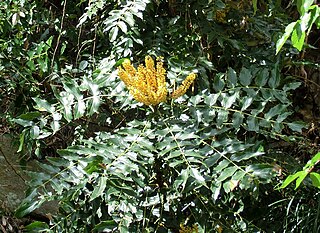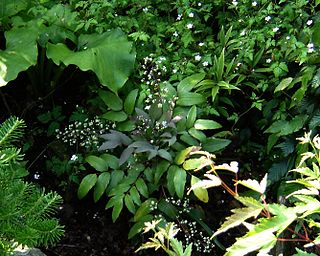
Berberis aquifolium, the Oregon grape or holly-leaved barberry, is a species of flowering plant in the family Berberidaceae, native to western North America. It is an evergreen shrub growing 1–3 meters tall and 1.5 m (5 ft) wide, with pinnate leaves consisting of spiny leaflets, and dense clusters of yellow flowers in early spring, followed by dark bluish-black berries.

Mahonia is a formerly accepted genus of approximately 70 species of shrubs or, rarely, small trees with evergreen leaves in the family Berberidaceae, native to eastern Asia, the Himalaya, North America, and Central America. They are closely related to the genus Berberis and as of 2023 the majority of botanical sources list it as a synonym for Berberis.
Karl Theodor Hartweg was a German botanist. He collected numerous new species of plants in Colombia, Ecuador, Guatemala, Mexico and California in the United States, collecting for the London Horticultural Society. Many of the species he discovered were formally published, with attribution, by George Gordon, the Foreman of the London Horticultural Society Gardens and a specialist in the conifers which were well represented in Hartweg's collections.

Berberis trifoliolata is a species of flowering plant in the family Berberidaceae, in southwestern North America. Common names include agarita, agrito, algerita, currant-of-Texas, wild currant, and chaparral berry. The name Agarita comes from the Spanish verb agarrar, which means "to grab". The ending "-ita" is often added to little things, so agarita means "grabs a little". This was probably said because the bush is a bit scratchy but does not have significant spines. Typical characteristics are grey-green to blue-grey leaves, yellow flowers in February to April and the red berries appearing in May. The most important harvest organ are the berries, though the roots and seeds can also be used.

Cycladenia humilis is the sole member of the monotypic genus Cycladenia. Known by the common name Sacramento waxydogbane, it is an uncommon plant native to the southwestern United States. Collections have mostly been from California, although the species has also been reported from Utah and Arizona, mostly on gypsum soils. It is found at some elevation in several mountain ranges in the region. One of the four varieties of this plant, called the Jones waxydogbane, is considered a threatened taxon. This is a fleshy perennial herb with dull green leaves and pinkish lavender flowers. The flowers begin as rolled tubes shaped like pea pods and then open into colorful funnel-shaped blooms.
Berberis henryi is a species of plant in the family Berberidaceae. It is endemic to China.

Berberis oiwakensis is a species of plant in the barberry family, Berberidaceae. It is native to Taiwan, China and Myanmar, where it occurs at elevations of 600 to 3800 m. It has recently been found naturalized in South Africa.

Berberis nevinii, known by the common name Nevin's barberry, is a species of flowering shrub in the barberry family.

Berberis japonica is a species of flowering plant in the family Berberidaceae, native to Taiwan. Despite the name, it is not native to Japan, though it has been known in cultivation there for centuries. The wild origins of this species have long puzzled botanists, but wild plants in Taiwan, previously known under the name Mahonia tikushiensis, appear most similar to the cultivated forms of B. japonica.
Berberis monyulensis is a shrub in the family Berberidaceae first described as a species in 1961. It is endemic to Tibet.

Berberis napaulensis Nepali: जमाने मान्द्रो is a shrub in the family Berberidaceae described as a species in 1821. It is native to China and the Himalayas. This species is used medicinally throughout the Sikkim Eastern Himalayas.
Berberis longipes is a shrub in the family Berberidaceae, first described in 1918. It is native to the States of Durango, Sinaloa, Sonora, and Chihuahua in Mexico.
Berberis angustifolia is a shrub in the family Berberidaceae, first described as a species in 1840.
Berberis ehrenbergii is a shrub in the Berberidaceae described as a species in 1847. It is native to the States of Chiapas, Tamaulipas, and Veracruz in southern Mexico.
Berberis lanceolata is a shrub in the Berberidaceae described as a species in 1840. It is endemic to Mexico, found in the States of Hidalgo, Oaxaca, Veracruz, and Puebla.
Berberis hartwegii is a shrub in the Berberidaceae described as a species in 1840. It is endemic to Mexico, found in the States of Hidalgo, San Luis Potosí, and Tamaulipas.

Berberis pallida is a shrub in the Berberidaceae described as a species in 1840. It is endemic to Mexico, known from the States of Guanajuato, Hidalgo, Oaxaca, Veracruz, Puebla, Querétaro, and Tamaulipas.
Berberis incerta is a shrub described as a species in 1901. It is endemic to eastern Mexico, known from the States of Hidalgo and Veracruz.
Berberis eutriphylla is a species of shrub in the Berberidaceae described as a species in 1901. It is endemic to northern and central Mexico, from Coahuila to Mexico State.
Berberis quinquefolia is a shrub in the family Berberidaceae, first described as a species in 1918. The species is endemic to Mexico, reported from the States of Puebla and Durango.








